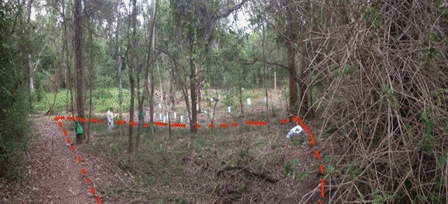
The Ekibin Creek community planting began early with last minute preparations: digging a few more holes, bringing buckets of water up from the creek and getting materials & documentation ready. Our first participants arrived around 9am and a group of 16 people of all ages gathered together under the Tallowood tree that formed one corner of our Three Trees Triangle that we started work on back in February.
Prof. Darryl Jones addressed the group and spoke about recent research and practice around koala preservation. From a low base decades ago, koalas are now being increasingly sighted across Toohey Forest. Over this time, better efforts have been made to connect up remaining bushland so that viable areas can be formed to sustain breeding koala populations. He talked of large-scale road-crossing projects such as the Compton Road land bridge, but indicated that much cheaper initiatives such as running ledges mounted on existing tunnels, pipes and bridges could also be effective. The key to this sort of development was monitoring: rather than relying on anecdote, regular observation using remote sensing should provide the data.
Prof. Jones speculated that Ekibin Creek's resident koala may be an older male who had decided to 'retire' here. Apparently this has been observed elsewhere where a koala finds a safe area that has resources, including suitable food sources and habitat.
After the talk, Sue Ackroyd demonstrated how to plant native shrubs and grasses. By this time our group had swelled to about 24 participants including Holland Park SHS teachers and families, members of surrounding suburbs and visitors from nearby environment groups. We broke up into smaller groups to plant grasses, shrubs and trees in the prepared bank next to the oval track. One group observed the squirrel glider colony. The event concluded around 11am.